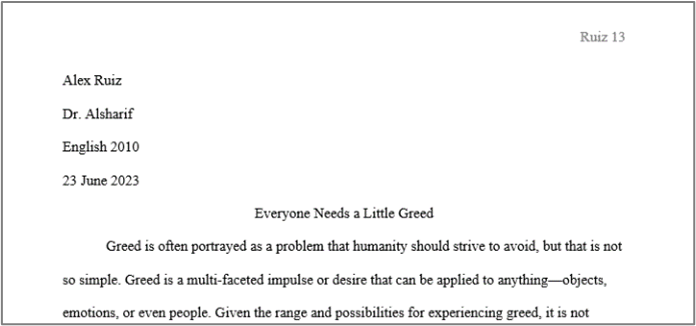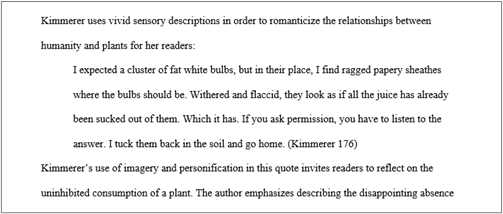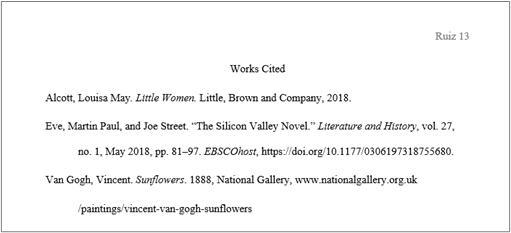The Modern Language Association (MLA) publishes a citation style guide used to standardize writing and cite information. MLA format is widely used in the humanities. This handout explains how to format writing assignments according to MLA (9th ed.) (section numbers listed in headings). This resource provides general information about formatting MLA papers, but writers should always tailor their work to their audience and assignment.

Internal headings are not commonly used in MLA. However, when used, headings in the body paragraphs should be left-aligned with the margin and include a line space above and below. Each level of heading should include two or more instances of use in the paper.

Writers are encouraged to limit the number of long quotes in a paper, but when quotes are longer than four lines, they are formatted as block quotes. Block quotes remain double spaced, are indented an additional .5 inch, are formatted without quotation marks, and include the in-text citation after the quote's end punctuation.

While block quotes are formatted to include punctuation after the quote, in-text citations include punctuation after the citation (“. . .” (Mitchell 23).). American academic writing, in general, places punctuation inside quotation marks (“. . . apart.”] unless followed by an in-text citation.
Place visual elements as close to the related text as possible. Double-space tables, labels, and captions.
Each table is labeled with a number and title; both should be left-aligned on separate lines above the table. If adapting data from a source’s table into a new table, place its source and notes in a caption below the table. To cite information from a table in-text, include the table number in square brackets after the page number e.g. (Smith et al. 18 [table 2]).
Example:
Table 1
Distribution of Literature Degrees in the U.S., 2014–2016
| Year | Bachelor’s Degrees | Master’s Degrees | Doctoral Degrees |
|---|---|---|---|
| 2014–15 | 16,008 | 2,517 | 762 |
| 2015–16 | 16,762 | 2,637 | 778 |
Adapted from: U.S. Department of Education, Institute of Education Sciences, National Center for Education Statistics. Digest of Education Statistics, 2017 ed., June 2017, table 297, nces.ed.gov/programs/digest/d07/tables/dt07_297.asp.
Other types of visual material (e.g., photograph, map, graph, or chart) should be labeled “Figure #” (usually abbreviated Fig.) and include an identifying caption below. If a writer chooses to give a full citation in the caption and does not cite it elsewhere, no entry is needed in the works cited.
Example (Full Citation):

Fig. 2 James Modarelli, NASA Insignia. 1959,
National Aeronautics and Space Administration.
www.nasa.gov/symbols-of-nasa.html
Example (Partial Citation):

Fig. 2 James Modarelli, NASA Insignia
